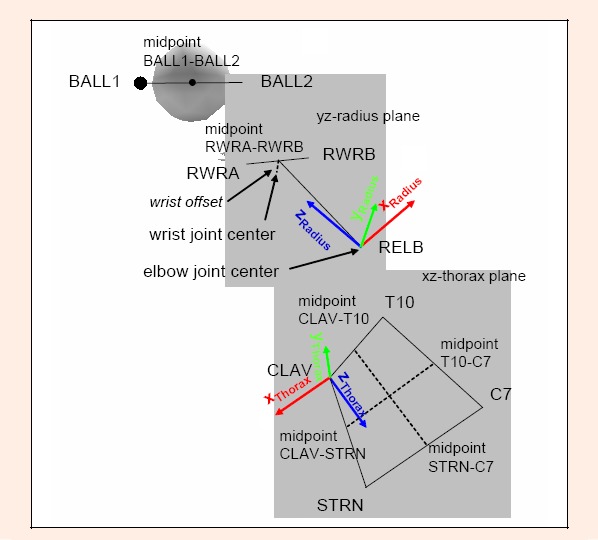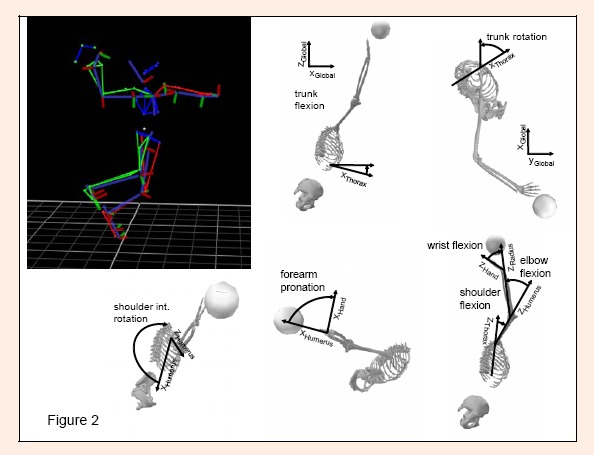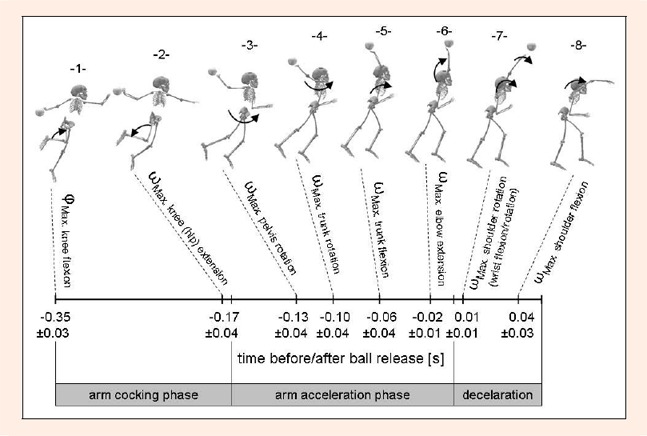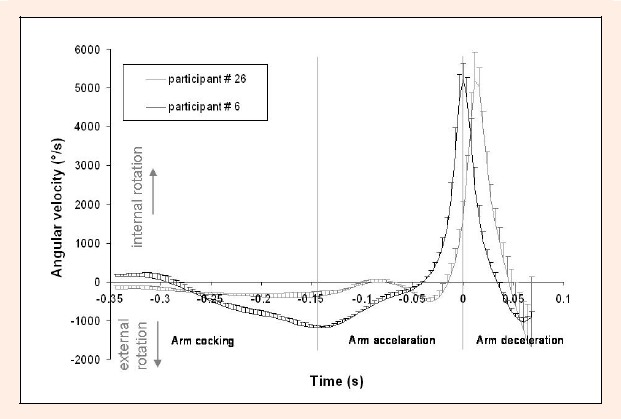Abstract
The jump throw is the most applied throwing technique in team- handball (Wagner et al., 2008); however, a comprehensive analysis of 3D-kinematics of the team-handball jump throw is lacking. Therefore, the purpose of our study was: 1) to measure differences in ball release speed in team- handball jump throw and anthropometric parameters between groups of different levels of performance and (2) to analyze upper body 3D-kinematics (flexion/extension and rotation) to determine significant differences between these groups. Three-dimensional kinematic data was analyzed via the Vicon MX 13 motion capturing system (Vicon Peak, Oxford, UK) from 26 male team-handball players of different performance levels (mean age: 21.2 ± 5.0 years). The participants were instructed to throw the ball (IHF Size 3) onto a target at 8 m distance, and to hit the center of a square of 1 × 1 m at about eye level (1.75 m), with maximum ball release speed. Significant differences between elite vs. low level players were found in the ball release speed (p < 0.001), body height (p < 0.05), body weight (p < 0.05), maximal trunk internal rotation (p < 0.05), trunk flexion (p < 0.01) and forearm pronation (p < 0.05) as well as trunk flexion (p < 0.05) and shoulder internal rotation (p < 0.001) angular velocity at ball release. Results of our study suggest that team-handball players who were taller and of greater body weight have the ability to achieve a higher ball release speed in the jump throw, and that an increase in trunk flexion and rotation angular velocity improve the performance in team-handball jump throw that should result in an increase of ball release speed.
Key points.
Team-handball players who were taller and of greater body weight have the ability to achieve a higher ball release speed.
An increase in trunk flexion, trunk rotation and shoulder internal rotation angular velocity should result in an increase of ball release speed.
Trunk movements are normally well observable for experienced coaches, easy correctable and therefore practical to improve the performance in team-handball jump throw of low level players during training without using complex measurement devices.
Key words: 3D-kinematics, angular velocity, ball throwing technique, ball release speed.
Introduction
In team-handball, the objective of the game is to score goals. To succeed in an attempt to score a goal, a team-handball player must maximize the precision of the throw as well as ball release speed. This is especially true when throwing from a distance of more than 8 m from the goal (backcourt position). It is well known that team-handball players use different throwing techniques based on their playing position and it is dictated by the movements of the defensive players. Previous studies of team-handball throws (Fradet et al., 2004; Gorostigia et al., 2005; Jöris et al., 1985; Pori et al., 2005; Sibila et al., 2003; Van den Tillaar and Ettema, 2004; 2007; Wagner and Müller, 2008) analyzed standing throws, standing throws with run-up, jump throws, and identified the ball release speed as the main performance factor determining the throwing movement. From these three different throwing techniques, the jump throw is the most frequently applied throwing technique in the game of team-handball. Wagner et al., 2008 found that 73 - 75% of all throws during the competitive team-handball game are jump throws. Although the jump throw is the most applied throwing technique in team-handball, a comprehensive analysis of 3D-kinematics of the team-handball jump throw is lacking.
However, Gorostiaga et al., 2005 analyzed team-handball players of different performance levels and found that age and body weight contributed significantly to differences in ball release speed during standing and three-step running throws. We also hypothesize that significant differences will be found in ball release speed in the team-handball jump throw, body height, and body weight between team-handball players of different performance levels.
Three-dimensional kinematics of the team-handball standing throw were investigated by Fradet et al., 2004, van den Tillaar and Ettema (2004; 2007) and Wagner and Müller, 2008. Van den Tillaar and Ettema, 2007 found that the angular velocity of the internal shoulder rotation at ball release and the maximal elbow extension contribute greatly to the ball release speed. Van den Tillaar and Ettema, 2004 suggested that 67% of the ball release speed was explained by the summation effects from the velocity of elbow extension and internal rotation of the shoulder. Significant differences in ball release speed and maximal internal rotation and wrist flexion angular velocity between two team- handball players of different performance levels were found by Wagner and Müller, 2008. Team-handball players are familiar with the standing throw as well as the jump throw, although only the jump throw is used frequently during training and competition. We hypothesize that significant differences will be found between groups of different performance levels in the jump throw, specifically regarding the throwing arm and trunk angular velocities and their timing. After reviewing the studies of van den Tillaar and Ettema (2004; 2007) and Wagner and Müller, 2008 we decided to analyze flexion/extension and rotation movements in the upper body.
Therefore, the aims of the study were: (1) to measure differences in ball release speed in team- handball jump throw and anthropometric parameters between groups of different performance levels and (2) to analyze upper body 3D-kinematics in the team-handball jump throw to determine significant differences between groups of different performance levels in the jump throw, specifically the throwing arm and trunk flexion/extension and rotation angular velocities and their timing. The findings of our study should provide new insights into the jump throw in team-handball and assist coaches in improving the performance of their athletes.
Methods
Participants
Twenty-six male volunteers (mean age: 21.2 ± 5.0 years, body weight: 76.9 ± 11.3 kg, body height: 1. 81 ± 0.07 m, training experience: 6.8 ± 5.2 years) participated in our study. All participants were physically healthy, in good physical condition and reported no injuries during the time of the study. The study was approved by the local ethics committee and all participants signed informed consent.
Participants were recruited from the Austrian National Handball Team (n = 5), adults (n = 6), juniors (n = 5), youth (n = 5) from a Regional Handball Team, and sport students (n = 5). The performance level of the participants based on their experience and performance in competition was determined by 5 experienced team-handball coaches (licensed coaches). The performance level (Table 1) for each participant was rated from one (players of the Austrian National Handball Team) to level six (novice with no or little experience in competition). Performance level was rated by the 5 coaches before testing and independent of throwing performance. After this procedure, two groups with different levels of performance were established. Level 1, 2 and 3 players were grouped together as elite team-handball players (performance level: 1.8 ± 0.8; training experience: 11.6 ± 3.2 years) and level 4, 5 and 6 players were grouped together as low level players (performance level: 5.1 ± 0.9; training experience: 2.7 ± 1.9 years).
Table 1.
Classification of the level of performance.
| LOP | Team | Experience in competition |
n |
|---|---|---|---|
| Level 1 | Austrian National Handball Team |
First Austrian HL First German HL First Spanish HL |
1 3 1 |
| Level 2 | Regional Team | Second Austrian HL Third German HL |
2 2 |
| Level 3 | Regional Team Junior Team |
Third Austrian HL Third Austrian HL |
2 1 |
| Level 4 | Junior Team | Austrian Junior Champ | 4 |
| Level 5 | Youth Team | Austrian Youth Champ | 4 |
| Level 6 | Youth Team Sport Students |
Less experience No experience (novice) |
1 5 |
HL = Handball League. Champ = Championship
Test protocol
After a general and a team- handball specific warm up of 20 min the participants performed vertical team-handball jump throws. To confirm that the jump throw was a vertical jump throw, the horizontal difference between take off and landing may not exceed more than 2 m. The participants were instructed to throw the ball (IHF Size 3) onto a target at 8 m distance, and to hit the center of a square of 1 × 1 m at about eye level (1.75 m), with maximum ball release speed. The subsequent evaluation was used only for those throws that hit the target. The participants had to continue to throw until 10 jump throws per participant were achieved. Of these 10 throws the six with the highest ball release speed for each player were included in the calculation.
Kinematic analysis
The experimental set-up consisted of a Vicon MX13 motion capture system (Vicon Peak, Oxford, UK) including eight cameras sampling at 250 frames per second. For kinematic analysis, 39 reflective markers of 14 mm diameter were attached to specific anatomical landmarks (Plug-In Gait Marker Set, Vicon Peak, Oxford, UK) of every participant. Three-dimensional coordinates of the 39 markers were reconstructed with the Nexus software (Nexus 1.3, Vicon, Oxford, UK) and smoothed using cross validation splines (Woltring, 1986). To calculate the joint centre positions, we used a three-dimensional model (Plug In Gait Model, Vicon Peak, Oxford, UK) dividing the body into lower and upper body models (Davis et al., 1991). The lower body model was defined as a system of rigid bodies including the pelvis and the left and right femur, tibia and foot (Kadaba et al., 1990) and the upper body model included the thorax, head, the left and right humerus, radius and hand (Rab et al., 2002). Leg length, shoulder offset, elbow and wrist width, and hand thickness were measured for each participant to identify joint centres. Head and thorax origins were calculated using each of the four markers constituting the segment. The orientation of these segments was identified by calculating three orthogonal axes directions (x-axis sagittal, y-axis transverse and z-axis longitudinal; Figure 1). Two of these axis directions were calculated directly from the marker data, and the third was determined perpendicularly to the plane defined by the direction of these two axes. The shoulder joint centers were calculated from the thorax segments using the measured shoulder offset (the longitudinal distance from the shoulder marker to the shoulder joint centre). To calculate the upper extremity joint centers from the proximal to distal direction we used joint centers of the proximal segments, the markers of the joints, the wand markers of the segments (to determine the plane) and the joint widths (elbow and wrist width) to determined the distance from the joint markers to the joint centers. The orientations of the extremity segments were labeled by the longitudinal axis (Figure 1), the transverse axis (from the distal joint centre to the distal joint marker) and the perpendicular sagittal axis, with the distal joint centre as the origin.
Figure 1.

Definition of thorax and radius segment coordinate systems, wrist joint center calculation, ball midpoint calculation and markers. C7: 7th cervical vertebrae; T10: 10th thoracic vertebrae; CLAV: Clavicle; STRN: Sternum; RELB: Right elbow; RWRA: Wrist thumb side; RWRB: Wrist small finger side of the upper body model.
Angle calculations
Three-dimensional joint angles (Cardan angles) were calculated by the relative orientation of the proximal and distal segments. The joint flexion angles (shoulder, elbow, and wrist flexion) were the angles determining the longitudinal axes of the proximal and distal segments (Figure 2). The angle directions were defined as positive for shoulder, elbow and wrist flexion and negative for shoulder and wrist hyperextension. The shoulder internal-external rotation angle was defined as the rotation of the humerus along the longitudinal axis of the humerus (Figure 2). A positive value corresponds to an internally rotated humerus. The forearm pronation and supination was calculated between the sagittal axis of the hand and the sagittal axis of the radius, where a positive value corresponded to a forearm pronation. Trunk rotation angle was defined between the sagittal axis of the thorax and those of the sagittal axis (xGlobal) of the measurement field (Figure 2). Finally, the trunk flexion was calculated between the projected sagittal thorax axis and the sagittal (xGlobal) of the measurement field (Kadaba et al., 1990; Rab et al., 2002). Our utilized method was similar to those used in recent studies (Fradet et al., 2004; Van den Tillaar and Ettema, 2007) analyzing kinematics of the team-handball throw, and identical to those used for bowling (Ranson et al., 2008) and the volleyball spike jump (Tilp et al., 2008; Wagner et al., 2009). The measurement accuracy of our model is described in Tilp et al., 2008 and the reliability of the kinematic variables in Ranson et al., 2008.
Figure 2.

Reconstructed marker trajectories and calculated segment axes in the team-handball jump throw situation as well as definition of joint angles for a right handed player.
Phase classification
In our study, the measured jump throws were separated into 3 different phases. These 3 phases depend on the phase separation for the team-handball standing throw (van den Tillar and Ettema, 2004; 2007). We termed the arm cocking phase as the time lag between the moment when the knee flexion angle became maximal (same side as throwing arm) and before the ball speed dramatically increases (the difference between ball release speed and the velocity of the centre of mass becomes positive). The maximal knee flexion angle was chosen because this occurrence was easily detectable and corresponds to the moment when the throwing arm moved backward. The arm acceleration phase corresponds with the phase of increasing ball release speed and was defined as the time lag from the end of the arm cocking phase until ball release. The arm deceleration phase was defined as the time lag between ball release and the moment when the shoulder internal rotation angle has a local minimum angle (Figure 3).
Figure 3.

Proximal-to-distal sequencings (mean ± SD) of the maximal angular velocities in the jump throw in team-handball. (φ=angle; ω=angular velocity).
Angular velocity and ball release speed
Angular velocities were calculated using the 5-point central difference method (Feltner and Dapena, 1989). To measure the ball release speed, the linear velocity of the centre of the ball was calculated and the centre of the ball was defined as the middle point of 2 markers that were positioned on the opposite sides of the ball (Figure 1). To determine the moment of ball release, the distance between the centre of the ball and the hand marker (head of the second metatarsal) was calculated. The distance between the centre of the ball and the hand marker increases abruptly at ball release (Van den Tillaar and Ettema, 2007).
Statistical analysis
All statistical analyses were performed using SPSS ver. 15. 0. (SPSS Inc., Chicago, IL). Means and standard deviations of the variables were calculated for descriptive statistics. Six groups of variables were used for statistical analysis: 1) performance (ball release speed, body height and weight), 2) maximal rotation angular velocity (trunk internal rotation, shoulder internal rotation and forearm pronation), 3) maximal flexion/extension angular velocity (trunk flexion, shoulder flexion, elbow extension and wrist flexion), 4) angular velocity at ball release (trunk flexion and shoulder internal rotation), 5) timing of the maximal rotation (trunk internal rotation, shoulder internal rotation and forearm pronation) and 6) timing of the maximal flexion/extension angular velocity variables (trunk flexion, shoulder flexion, elbow extension and wrist flexion). Multivariate linear models were calculated to determine if all variables within a group of variables differ significantly between elite and low level players. If the multivariate analysis resulted in a significant differ-ence, (p < 0.05) independent t-tests (post-hoc test) were calculated for all variables within this group. Significance was set at (p < 0.05) and effect size (η2) was defined as small for η2 > 0.01, medium for η2 > 0.09 and large for η2 > 0.25 (Cohen, 1988).
Results
Mean (± SD) values of ball release speed, body height and weight, statistical results of the multivariate group analysis of performance and results of independent t-tests are depicted in Table 2. Significant differences with a large effect (p < 0.001, η2 = 0.64, 1-β = 0.99) were found for the performance between elite and low level players. Independent t-tests showed significant differences between elite and low level players in ball release speed (p < 0.001, η2 = 0.62, 1-β = 1.00), body height (p < 0.05, η2 = 0.18, 1-β = 0.60) and body weight (p < 0.05, η2 = 0.24, 1-β = 0. 74).
Table 2.
Summary of performance variables (ball release speed), body height and weight. Data are means (±SD).
| Elite players (n=12) |
Low level players (n=14) |
Effect size (η2) |
Power (1-β) |
|
|---|---|---|---|---|
| Peformance *** | .64 | .99 | ||
| Ball release speed (m·s-1) | 22.3 (1.5) | 18.0 (1.9)*** | .62 | 1.00 |
| Body height (m) | 1.85 (.08) | 1.78 (.07)* | .18 | .60 |
| Body weight (kg) | 83 (12) | 72 (9)* | .24 | .74 |
* < 0.05
*** < 0.001.
The mean (± SD) values of the maximal angular velocities and the angular velocities at ball release are listed in Table 3. Multivariate group analysis showed significant differences with a large effect size between elite and low level players for the maximal rotation angular velocities (p < 0.05, η2 = 0.31, 1-β = 0.67), maximal flexion/extension angular velocities (p < 0.05, η2 = 0.44, 1-β = 0.85), and angular velocities at ball release (p < 0.01, η2 = 0.41, 1-β = 0.92). In detail, significant differences were found between the two groups of participants for the maximal trunk internal rotation (p < 0.05, η2 = 0. 16, 1-β = 0.52), forearm pronation (p < 0.05, η2 = 0.20, 1-β = 0.65) and trunk flexion angular velocity (p < 0.01, η2 = 0.36, 1-β = 0.94), as well as trunk flexion (p < 0.05, η2 = 0.37, 1-β = 0.95) and shoulder internal rotation angular velocity (p < 0.01, η2 = 0.16, 1-β = 0.54) at ball release.
Table 3.
Summary of maximal rotation (trunk internal rotation, shoulder internal rotation and forearm pronation) and flexion/extension angular velocity (°/s) parameters (trunk flexion, shoulder flexion, elbow extension and wrist flexion) as well as parameters at ball release (trunk flexion, shoulder internal rotation). Data are means (±SD).
| Elite players (n=12) |
Low level players (n=14) |
Effect size (η2) |
Power (1-β) |
|
|---|---|---|---|---|
| Rotation * | .31 | .67 | ||
| Max. trunk int. rotation | 756 (52) | 667 (138) * | .16 | .52 |
| Max. shoulder int. rotation | 5039 (896) | 4955 (1042) | .01 | .06 |
| Max. forearm pronation | 1354 (491) | 1954 (720) * | .20 | .65 |
| Flexion/extension * | .44 | .85 | ||
| Max. trunk flexion | 474 (100) | 328 (108) ** | .36 | .94 |
| Max. shoulder flexion | 1112 (219) | 1046 (245) | .02 | .11 |
| Max. elbow extension | 1626 (133) | 1526 (241) | .06 | .23 |
| Max. wrist flexion | 807 (166) | 864 (445) | .01 | .07 |
| Ball release ** | .41 | .92 | ||
| Trunk flexion | 258 (104) | 128 (74) * | .37 | .95 |
| Shoulder internal rotation | 4428 (1129) | 3450 (1177) ** | .16 | .54 |
* p < 0.05
** p < 0.01.
The mean (±SD) values for the timing of the maximal angular velocities are shown in Table 4. Multivariate group analysis revealed no significant differences between elite and low level players for rotation (p = 0.19, η2 = 0.19, 1-β = 0.39) and flexion/extension timing (p = 0.07, η2 = 0.33, 1-β = 0.62).
Table 4.
Summary of the timing (s) of the maximal rotation (trunk internal rotation, shoulder internal rotation and forarm pronation) and flexion/extension angular velocity variables (trunk flexion, shoulder flexion, elbow extension and wrist flexion). Data are means (±SD).
| Elite players (n=12) |
Low level players (n=14) |
Effect size (η2) |
Power (1-β) |
|
|---|---|---|---|---|
| Rotation | .19 | .39 | ||
| Max. trunk int. rotation | -.087 (.018) | -.104 (.028) | ||
| Max. shoulder int. rotation | .003 (.003) | .005 (.006) | ||
| Max. forearm pronation | .012 (.010) | .016 (.011) | ||
| Flexion/extension * | .33 | .62 | ||
| Max. trunk flexion | -.051 (.020) | -.065 (.057) | ||
| Max. shoulder flexion | .051 (.005) | .038 (.035) | ||
| Max. elbow extension | -.018 (.014) | -.011 (.009) | ||
| Max. wrist flexion | .000 (.033) | .018 (.022) |
* p < 0.05.
Proximal-to- distal sequencings (mean ± SD values of all participants) of the maximal angular velocities in the jump throw in team-handball are depicted in Figure 3 (2-8).
Discussion
Ball release speed, body height and weight
As with previous studies in team handball (Gorostiaga et al., 2005; Van den Tillaar and Ettema, 2006a, Wagner and Müller, 2008) we found significant differences in ball release speed between elite and low level players (Table 2). The results of our study confirm that ball release speed is the main important factor determining throwing performance in team handball. The elite players in our study achieved ball release speed of 22.3 ± 1.5 m·s-1 which are lower but comparable to those described by Pori et al., 2005 for Slovenian National Handball Team players (24.0 ± 1.4 m/s) and Sibila et al., 2003 for Slovenian elite team-handball players (24.1 ± 1.3 m·s-1) when performing a jump throw. Therefore, the level of our elite players is comparable to international level players.
Relevant statistical differences between elite and low level players were also found in body height and body weight (Table 2). We suggest that team-handball players of higher body height and weight have the ability to achieve a higher ball release speed in the jump throw. These results support our experience associated with elite team-handball players, (particularly backcourt players, who have to throw with high ball release speed), weigh more than 90 kg and are taller than 1.90 m. The advantage of height and weight was also evident as the Olympic Champion 2008, France, whose backcourt players weighed 96.5 ± 7.7 kg, and were 1.93 ± 0.05m tall as listed in the official homepage of the International Handball Federation (IHF). These anthropometric characteristics may be the precondition for higher ball release speed in the jump throw because of longer moment arms and muscles that may be responsible for greater strength and power. Gorostiaga et al., 2005 found significant differences in body weight, maximal strength, muscle power output of the upper extremity muscles and team-handball throwing velocity between Spanish male elite and amateur handball players.
Maximal angular velocities
The results of our study are in agreement with other studies in team-handball (Van den Tillaar and Ettema, 2004; 2007; Wagner and Müller, 2008) regarding the maximal angular velocities of the throwing arm. Maximal angular velocities of shoulder internal rotation, elbow extension and wrist flexion of our elite as well as low level players (Table 3) were higher than those found by Van den Tillaar and Ettema, 2007 (shoulder: 3426 ± 838°/s; elbow: 1430 ± 246°/s; wrist: 568 ± 193°/s) for the standing throw in team- handball and lower than those found by Wagner and Müller, 2008. A world class team-handball player reaches a maximal angular velocity of shoulder internal rotation of 8130 ± 1200°/s and a ball release speed of 25.1 ± 0.8 m/s during a standing throw. Because of the difference in the shoulder internal rotation angular velocity between a world class team- handball players (Wagner and Müller, 2008) and Austrian (Wagner and Müller, 2008) as well as Norwegian top and first class players (Van den Tillaar and Ettema, 2007) it was surprising that we were not able to determine significant differences in the maximal shoulder internal rotation angular velocity between elite and low level players in the present study. Elite as well as low level players were able to reach a shoulder internal rotation angular velocity of approximately 5000°/s. We suggested that the ability to reach a shoulder internal rotation angular velocity of more than 7000°/s is limited to just a few players worldwide, which are able to throw the ball faster than 25 m/s in the jump throw in team-handball.
However, Van den Tillaar and Ettema, 2007 found a significant correlation between ball release speed and angular velocity of the shoulder internal rotation at ball release (r = 0.67, p = 0.024) for the standing team-handball throw. In our study, we hypothesized to find significant differences in the shoulder internal rotation angular velocity at ball release between elite vs. low level players, which could be confirmed in our results shown in Table 3. Elite vs. low level players differ significantly in the shoulder internal rotation angular velocity at ball release. Based on the results of Van den Tillaar and Ettema, 2007 and our study of team-handball players, we cannot emphasize enough the importance of the angular velocity of shoulder internal rotation at ball release.
As shown in Figure 4, we found that participants who reached a lower ball release speed may have the ability to produce a high maximal angular velocity of shoulder internal rotation but not at ball release (Figure 4, participant # 26). Van den Tillaar and Ettema, 2006b stated that the angular velocity of shoulder internal rotation in the team-handball standing throw with a skilled vs. an unskilled arm produced significantly different values at ball release (skilled: 2555 ± 991°/s, unskilled: 1220 ± 728°/s). Therefore, we postulate that the ability to reach the maximal angular velocity of shoulder internal rotation at the right time (near ball release) may be achieved by effective coaching.
Figure 4.

Angular velocities of shoulder internal rotation of two participants with similar maximal angular velocities (participant # 6: 5348 ± 302°/s; participant # 26: 5319 ± 587°/s) but different angular velocities (participant # 6: 5275 ± 375°/s; participant # 26: 1634 ± 435°/s) at ball release (Participant # 6: Elite player, ball release speed 24.6 ± 1.0 m/s; participant # 26: Low level player, ball release speed 16.1 ± 1.0 m/s).
In our study, we found no significant differences between elite vs. low level players in the team-handball jump throw for the shoulder flexion, elbow extension and wrist flexion. It was surprising to find an increase in the maximal forearm pronation angular velocity of the low level players compared to the elite players because we hypothesized to find higher maximal angular velocities in the elite vs. low level players. Because the ball release speed of the low level players compared to the elite players was lower, the ability to reach a higher maximal forearm pronation angular velocity may not be a performance determining parameter in team-handball jump throw or may be counterproductive when attempting to reach a higher ball release speed. Further studies analyzing the forearm and finger movements during team-handball throwing are warranted to measure the influence of the forearm pronation on the energy flow from the forearm to the fingers and the ball.
The importance of the fast trunk flexion to execute the team-handball jump throw was indicated by the significant differences of the maximal trunk flexion angular velocity and trunk flexion angular velocity at ball release between elite vs. low level players (Table 3). In our participants, we found that it was necessary for them to execute the trunk movement either with the proximal-to- distal sequence from the trunk to the throwing arm (Table 4 and Figure 2) or aquired as the result of experience and game competition. During competition, the throwing player during offense anticipates the strong defensive play from a defensive player and attempts to move the trunk forward as quickly as possible before the offensive player is attacked (immediately before ball release, which resulted in a higher trunk flexion angular velocity at ball release of the elite vs. low level players as shown in Table 3. The elite players with ample competition and training experience may have already habitually adopted this trunk movement and have exhibited the movement during testing.
However, significant differences between elite vs. low level players were also found in the maximal trunk internal rotation angular velocity. Elite players reached higher trunk internal rotation angular velocities than those with less experience in training and competition. We suggest that a dynamic trunk flexion and rotation is important to improve the performance in team-handball jump throws that resulted in an increase of ball release speed. This is new information enhancing recent studies (Fradet et al., 2004; Gorostigia et al., 2005; Jöris et al., 1985; Müller, 1982; Pori et al., 2005; Sibila et al., 2003; Van den Tillaar and Ettema, 2004; 2007; Wagner and Müller, 2008) analyzing the throwing movement in team-handball and may be helpful for coaches in the training process. Trunk movements are normally well observable for experienced coaches, easy correctable and therefore practical to improve the performance in team-handball jump throw of low level players during training without using complex measurement devices.
Timing and proximal-to-distal sequencing
As shown in Table 4, we found no significant difference in the timing of the maximal rotation and flexion/extension trunk and throwing arm movements. Elite as well as low level players used a similar proximal-to-distal sequencing in the team-handball jump throw as shown in Figure 2. We suggest that the minimal requirement in team-handball throwing, a proximal-to-distal sequencing from the trunk to the upper arm, forearm and hand is detectable for all participants measured in the study.
Conclusion
We examined the team-handball jump throw that is the most often applied throwing technique in team-handball (Wagner et al., 2008). We found significant differences in ball release speed, body height and weight between elite and low level players. We suggest that team-handball players of higher body height and weight have the ability to achieve a higher ball release speed in the jump throw, which is in agreement with recent studies in team-handball (Gorostiaga et al., 2005. Significant differences between elite and low level players were also found in the maximal trunk flexion and trunk internal rotation angular velocity as well as the trunk flexion and shoulder internal rotation angular velocity at ball release. Whereas the importance of a high shoulder internal rotation angular velocity at ball release in the team-handball throwing performance were also shown by Van den Tillaar and Ettema, 2007. The differences in the trunk movements between elite vs. low level players give new insights into the jump throw in team-handball. We suggest that an increase in trunk flexion and rotation angular velocity improve the performance in team-handball jump throw that should result in an increase of ball release speed. The results of our study could aid coaches in improving the performance of their athletes; however, additional training studies in team-handball players are warranted..
Acknowledgements
The authors would like to thank Miriam Klous from the Department of Kinesiology, Motor Control Laboratory, Pennsylvania State University for assistance during data collection.
Biographies

Herbert Wagner
Employment
PostDoc at the Department of Sport Science and Kinesiology, and CD-Laboratory “Biomechanics in Skiing”, University of Salzburg, Austria.
Degree
PhD.
Research interests
Motor control and motor learning, movement variability, performance in sport games.
E-mail: herbert.wagner@sbg.ac.at

Michael Buchecker
Employment
Research assistant and PhD candidate at the Department of Sport Science and Kinesiology, and CD-Laboratory “Biomechanics in Skiing”, University of Salzburg, Austria.
Degree
MSc.
Research interests
Applied Biomechanics, Rehabilitation, Training and Testing.
E-mail: michael.buchecker@sbg.ac.at

Serge P. von Duvillard
Employment
College of Idaho.
Degree
PhD, FACSM, FECSS.
Research interests
Applied/Exercise Physiology, Testing and Monitoring of Elite Athletes, Biomarkers of Performance, Exercise Biochemistry, Cardiac Patients and Rehabilitation, etc...
E-mail: svonduvillard@collegeofidaho.edu

Erich Müller
Employment
Head of the Department of Sport Science and Kinesiology, and CD-Laboratory “Biomechanics in Skiing”, University of Salzburg, Austria.
Degree
PhD, Professor.
Research interests
Biomechanics; Training and Coaching; Motor Learning.
E-mail: erich.mueller@sbg.ac.at
References
- Cohen J. (1988) Statistical Power Analysis for the Behavioral Sciences 2ndedition Mahwah, NJ: Lawrence Erlbaum Associates [Google Scholar]
- Davis R.B., Õunpuu S., Tyburski D., Gage J.R. (1991) A gait analysis data collection and reduction technique. Human Movement Science 10, 575-587 [Google Scholar]
- Feltner M., Dapena J. (1989) Three-dimensional interactions in a two-segment kinetic chain. Part II: Application to the throwing arm in baseball pitching. International Journal of Sports Biomechanics 5, 420-450 [Google Scholar]
- Fradet L., Botcazou M., Durocher C., Cretual A., Multon F., Prioux J., Delamarche P. (2004) Do handball throws always exhibit a proximal-to-distal segment sequence? European Journal of Sport Science 22, 439-447 [DOI] [PubMed] [Google Scholar]
- Gorostiaga E.M., Granados C., Ibanez J., Izquierdo M. (2005) Differences in physical fitness and throwing velocity among elite and amateur male handball players. International Journal of Sports Medicine 37, 225-232 [DOI] [PubMed] [Google Scholar]
- Jöris H.J.J., Edwards van Muyen A.J., van Ingen Schenau G.J., Kemper H.C.G. (1985) Force, velocity and energy flow during the overarm throw in female handball players. Journal of Biomechanics 18, 409-414 [DOI] [PubMed] [Google Scholar]
- Kadaba M.P., Ramakrishnan H.K., Wooten M.E. (1990) Measurement of lower extremity kinematics during level walking. Journal of Orthopaedic Research 8, 383-392 [DOI] [PubMed] [Google Scholar]
- Müller E. (1982) Movement transfers in throwing movements. Leis-tungssport, 12, 314-322 (In German) [Google Scholar]
- Pori P., Bon M., Sibila M. (2005) Jump shot performance in team-handball. A kinematic model evaluated on the basis of expert modeling. International Journal of Fundamental and Applied Kinesiology 37, 40-49 [Google Scholar]
- Rab G., Petuskey K., Bagley A. (2002) A method for determination of upper extremity kinematics. Gait and Posture 15, 113-119 [DOI] [PubMed] [Google Scholar]
- Ranson C.A., Burnett A.F., King A., Patel N., O’Sullivan P.B. (2008) The relationship between bowling action classification and three-dimensional lower trunk motion in fast bowlers in cricket. Journal of Sports Science 26, 267-276 [DOI] [PubMed] [Google Scholar]
- Sibila M., Pori P., Bon M. (2003) Basic kinematic differences between two types of jump shot techniques in handball. Acta Universita Palacki Olomuc 33, 19-26 [Google Scholar]
- Tilp M., Wagner H., Müller E. (2008) Differences in 3D kinematics between volleyball and beach volleyball spike movements. Sports Biomechanics 7, 386-397 [DOI] [PubMed] [Google Scholar]
- Van den Tillaar R., Ettema G. (2004) A Force-velocity relationship and coordination patterns in overarm throwing. Journal of Sport Science and Medicine 3, 211-219 [PMC free article] [PubMed] [Google Scholar]
- Van den Tillaar R., Ettema G. (2006a) A comparison between novices and experts of the velocity-accuracy trade-off in overarm throwing. Perceptual and Motor Skills 103, 503-514 [DOI] [PubMed] [Google Scholar]
- Van den Tillaar R., Ettema G. (2006b) A comparison of performance and kinematics in throwing with the dominant and non-dominent arm in handball players. 14th International Symposium on Biomechanics in Sports, 14-18 July, Salzburg-Austria. Proceedings 165-168 [Google Scholar]
- Van den Tillaar R., Ettema G. (2007) A three-dimensional analysis of overarm throwing in experienced handball players. Journal of Applied Biomechanics 23, 12-19 [DOI] [PubMed] [Google Scholar]
- Wagner H., Müller E. (2008) Motor learning of complex movements. The effects of applied training methods (differential and variable training) to the quality parameters (ball velocity, accuracy and kinematics) of a handball throw. Sports Biomechanics 7, 54-71 [DOI] [PubMed] [Google Scholar]
- Wagner H., Kainrath S., Müller E. (2008) Coordinative and tactical parameters of team-handball throw. The correlation of level of performance, throwing quality and selected technique-tactical parameters. Leistungssport 38(5), 35-41 (In German [Google Scholar]
- Wagner H., Tilp M., von Duvillard S.P., Müller E. (2009) Kinematic analysis of volleyball spike jump. International Journal of Sports Medicine 30, 760-767 [DOI] [PubMed] [Google Scholar]
- Woltring H.J. (1986) A FORTAN package for generalized cross-validatory spline smoothing and differentation. Advances Engineering Software 8, 104-113 [Google Scholar]


